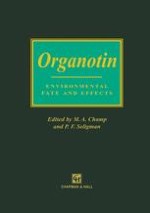1996 | OriginalPaper | Buchkapitel
Changes in Concentrations of Organotins in Water and Sediment in England and Wales Following Legislation
verfasst von : M. E. Waite, J. E. Thain, M. J. Waldock, J. J. Cleary, A. R. D. Stebbing, R. Abel
Erschienen in: Organotin
Verlag: Springer Netherlands
Enthalten in: Professional Book Archive
Aktivieren Sie unsere intelligente Suche, um passende Fachinhalte oder Patente zu finden.
Wählen Sie Textabschnitte aus um mit Künstlicher Intelligenz passenden Patente zu finden. powered by
Markieren Sie Textabschnitte, um KI-gestützt weitere passende Inhalte zu finden. powered by
This chapter reports the results of monitoring environmental concentrations of tributyltin (TBT) in the United Kingdom from 1986 to 1988. The UK government implemented legislation in 1986, that limited the amount of tin in copolymer and free-association tributyltin-based antifouling paints. This was followed in 1987 by a ban on the use of TBT-based paints on boats under 25 m in length and on mariculture equipment. Concentrations of TBT have been monitored in seawater and sediments from estuaries that have traditionally supported shellfisheries and are popular centers of boating activity. By 1988, concentrations of TBT in water samples taken close to sites of oyster and mussel cultivation were approximately half of the concentrations recorded in 1986. However, at all of these sites in 1988 the concentrations of TBT in the water exceeded 2 ng l-1, which is the environmental quality standard (EQS) set by the United Kingdom for the protection of marine life. The concentrations in many areas were above the toxicological threshold values of a variety of species. Water samples from marinas have also been analyzed, and in some cases concentrations of TBT in excess of 1000 ng l-1 have been recorded; however, by 1988, concentrations of TBT in the water of several marinas had decreased to approximately a quarter of the values recorded in 1986. The concentrations of TBT in sediments were highest in samples taken close to high-density boat moorings or in marinas. Such samples contained concentrations of TBT >1 µg g-1 (dry weight). Water samples have also been taken from commercial harbors, major waterways, and close to anchorages. It is difficult to assess the contribution of shipping to the inputs of TBT to the environment, when ships share the same body of water with small boats and yachts. However, the hosing-down of ships in dry-dock has been identified as a major source of input of TBT to the aquatic environment. Concentrations of TBT in major rivers, lakes, and the Norfolk Broads have been recorded. Levels of TBT in excess of 1000 ng l-1 have been measured in samples from some freshwater marinas and boatyards. The spillage of timber-treatment chemicals, containing TBT, from riverside storage facilities, has sometimes been the cause of major inputs of TBT to the freshwater environment. The distribution of organotin (tributyltin and dibutyltin) throughout the water column has been investigated. Maximum concentrations occur in the surface microlayer and minimum values near the bottom. Concentrations in samples from the surface microlayer, taken with a Garrett screen sampler, were as much as 27 times greater than those in subsurface waters. It is probable that such high concentrations in the surface microlayer may have deleterious effects on both the neuston and on organisms of the littoral zone.
